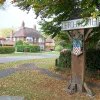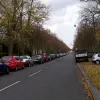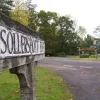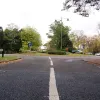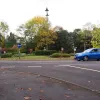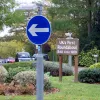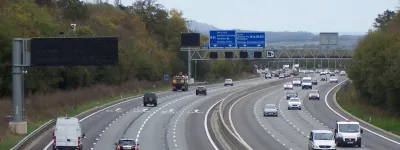Created as a focal point on the perimeter of the park, it was opened in 1905 as a circular open space with a statue of Columbus at its centre. It sounds for all the world like just another thing in a junction, except that this one was designed by William P Eno, a man known for pioneering ideas in road safety, and that it was described almost from the beginning as a "traffic circle". Without a doubt it had been designed to look pleasant at an important gateway to Central Park. But it was also, for the first time anywhere in the world, a circular junction with a central island that was designed to facilitate the movement of road traffic.
Columbus Circle is a major landmark in New York and its statue is the point from which distances to the city are measured. The first roundabout in the UK followed just four years later but was an altogether more low-key affair: a six-way junction in the southern part of Letchworth Garden City in Hertfordshire called Sollershott Circus.
Letchworth is a sleepy sort of place - rather like an overgrown village, full of overhanging trees and rambling houses, but with a ruthlessly organised and rigid street network.
Its through routes are really avenues, designed with rows of trees marching away to a distant focal point. This one - Broadway - is the main approach to the town centre from the south, and in the distance is an impressive fountain in the town's central square.
Where Broadway meets two other roads - Spring Road, Sollershott East and Sollershott West - the six-way junction was considered unusual and unwieldy enough by early twentieth century planners that it required something radical: a roundabout.
Here it is, seen from Spring Road: Sollershott Circus. Initially a glorified traffic island, it is barely modified from its original appearance - apart from some more ambitious gardening work in the centre - and yet it is very obviously a modern roundabout.
None of the roads here are particularly busy, which is just as well because the geometry of the junction is a little crude by modern standards. The entrance and exit points all require sharpish turns onto the roundabout itself.
So much for the development of the physical roundabout itself. A circular roadway and a central island doesn't quite complete the job, and it would take the rest of the twentieth century to perfect the priority rules, regulations, layout and geometry that make the junction we know today.
Picture credits
- Photograph of Columbus Circle taken from an original made available by the Library of Congress with no known rights restrictions.
- Photograph of St George's Circus taken from an original image by Martin Addison, used under Creative Commons Attribution-Share Alike 2.0 licence.
